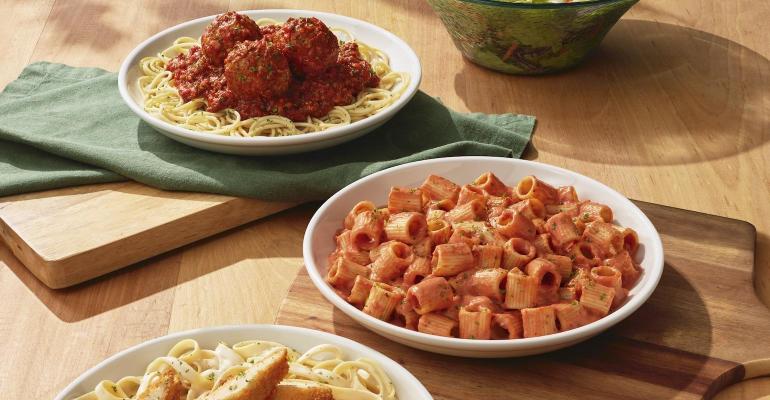Despite reports of trade down activity across the casual dining segment, it seems people still really want to eat at Olive Garden and LongHorn Steakhouse. The two chains drove much of Darden Restaurants’ second quarter results, reported Friday morning. Those results broken out included same-store sales growth of 4.1% at Olive Garden and 4.9% same-store sales growth for LongHorn.
Overall, Darden’s same-store sales were down 1.3%, including a 1.7% decline in its fine dining segment. Guest counts also declined by 4.8% but were flat at Olive Garden and down by just 1% at LongHorn. Executives noted that despite the overall comp and traffic declines, the company continued to outpace industry benchmarks. Further, CEO Rick Cardenas said guest satisfaction scores reached all-time highs during the quarter, while Thanksgiving business at Ruth’s Chris, Capital Grille, Eddie V’s, and Seasons 52 set new daily sales records.
“There was some softness in fine dining during the (second) quarter, but we’re encouraged by strong holiday bookings,” Cardenas said.
Still, the quarterly spotlight belonged to Olive Garden and LongHorn. Olive Garden’s sales performance was buoyed – once again – by the Never-Ending Pasta Bowl, which was brought back at the same price point as last year.
“This made it an even stronger value,” Cardenas said. “Guest demand was higher this year.”
Olive Garden’s flat guest counts were about 480 basis points above the industry average. Cardenas also noted that the Never-Ending Pasta promotion helped drive Olive Garden’s sales past the $5 billion mark on a trailing 52-week basis for the first time in the company’s 41-year history.
Executives also said they are optimistic about easing inflation in mid-2024, which will help offset softer checks, much of which is being driven by lower alcohol sales. However, CFO Raj Vennam predicted foot traffic will continue to be challenged in the new year. The softer traffic in Q2 came largely from consumers in the $50,000 salary and below cohort.
“The consumer appears to be more resilient, but more selective. Our data shows that we’re moving back to a pre-Covid demographic mix, which gets us to feel closer to what normal is,” Cardenas said. “Across all segments, incomes about $200,000 and above have a higher mix than last year but are still below pre-Covid levels. Below $75,000 are under last year, but still above pre-Covid. For those over 65 years old, the frequency has grown, and dining has shifted more to lunch so that gives you a little more check mix.”
He added that the company’s value proposition and diverse portfolio positions it well for these types of consumer behaviors. Cardenas said he is also pleased with the profitable sales growth the company has experienced, noting “that is what we shoot for.” All the company’s “other business” brands, including Cheddar’s, achieved that profitable sales growth goal during the quarter.
Executives added that the company’s overall performance has outpaced its segment peers because it has priced more conservatively, and it has prioritized execution. On the pricing side, Vennam said the company has taken about a 17-percent increase in the last four years cumulatively.
“For the same timeframe, if you look at the full-service (Consumer Price Index), it’s 25%. So, we have created a 700-basis point gap in that time. And limited service is up 29%, so we have a 1,200-basis point gap with them,” he said. “We’ve been prudent about pricing thoughtfully to make sure we’re creating this gap … which is one of the drivers of our traffic outperformance.”
Finally, much of the company’s execution comes from enhancements in labor productivity. Cardenas said turnover rates are lower this year compared to the last few years, and the company continues to invest in training for both new and existing employees. It has also invested in forecasting and scheduling tools that leverage AI, which has contributed to lower turnover rates.
“Over the next 12 months, we will continue to invest in technology to make it easier for our teams to execute; better AI tools for scheduling, and if we schedule better, we execute better and that drives performance,” he said.
Ruth’s Chris integration
The Ruth’s Chris integration, stemming from Darden’s $715 million acquisition of the company in June, is on track to be completed by the end of fiscal year. With the fine dining concept folded into the company’s mix, revenues during Q2 were up 9.7% year-over-year. In October, 21 Ruth’s Chris restaurants were transitioned to Darden’s distribution center. The plan is to continue transitioning restaurants through the first part of 2024.
“This phased approach allows us to gather learnings and capture supply chain synergies,” Cardenas said.
During this integration process, Darden has eliminated third-party delivery from the Ruth’s Chris business model. This decision wasn’t just about price or profit, Cardenas said, but also about execution.
“What it does to the teams and how we can execute our existing to-go business? We’ve made investments the last few years to make the to-go experience better for consumers and we’ll continue to do that,” he said. “We’re comfortable with this decision.”
Quarterly highlights
- Total sales increased 9.7% to $2.7 billion, driven by a blended same-restaurant sales increase of 2.8% and sales from the addition of 78 company-owned Ruth's Chris restaurants and 45 other net new restaurants
- Same-restaurant sales: Consolidated Darden, 2.8 %; Olive Garden, 4.1 %; LongHorn Steakhouse, 4.9 %; Fine Dining, -1.7%; Other Business, -1.1%
- The company opened 17 restaurants during the quarter, bringing the fiscal year total new openings to 27 restaurants in 16 states.
Contact Alicia Kelso at [email protected]

